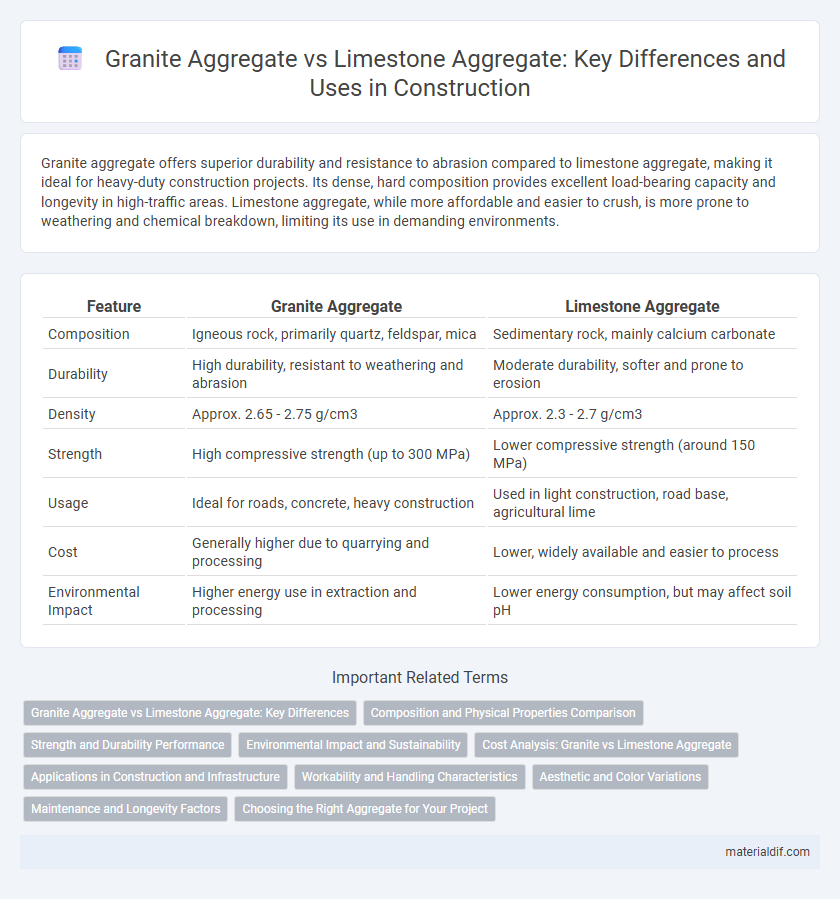Granite aggregate offers superior durability and resistance to abrasion compared to limestone aggregate, making it ideal for heavy-duty construction projects. Its dense, hard composition provides excellent load-bearing capacity and longevity in high-traffic areas. Limestone aggregate, while more affordable and easier to crush, is more prone to weathering and chemical breakdown, limiting its use in demanding environments.
Table of Comparison
| Feature | Granite Aggregate | Limestone Aggregate |
|---|---|---|
| Composition | Igneous rock, primarily quartz, feldspar, mica | Sedimentary rock, mainly calcium carbonate |
| Durability | High durability, resistant to weathering and abrasion | Moderate durability, softer and prone to erosion |
| Density | Approx. 2.65 - 2.75 g/cm3 | Approx. 2.3 - 2.7 g/cm3 |
| Strength | High compressive strength (up to 300 MPa) | Lower compressive strength (around 150 MPa) |
| Usage | Ideal for roads, concrete, heavy construction | Used in light construction, road base, agricultural lime |
| Cost | Generally higher due to quarrying and processing | Lower, widely available and easier to process |
| Environmental Impact | Higher energy use in extraction and processing | Lower energy consumption, but may affect soil pH |
Granite Aggregate vs Limestone Aggregate: Key Differences
Granite aggregate features higher hardness and durability due to its igneous rock origin, making it ideal for heavy-duty construction projects, while limestone aggregate, being sedimentary, offers better workability and cost-effectiveness for general purposes. Granite's mineral composition results in superior resistance to abrasion and weathering compared to the softer, more porous limestone which can absorb water and degrade over time. Choosing between granite and limestone aggregate depends on project requirements such as load-bearing capacity, exposure to elements, and budget constraints.
Composition and Physical Properties Comparison
Granite aggregate consists primarily of quartz, feldspar, and mica, providing high hardness and excellent durability, whereas limestone aggregate is mainly composed of calcite, resulting in a softer and more porous material. The high compressive strength and abrasion resistance of granite make it suitable for heavy-duty construction, while limestone's lighter weight and easier workability favor applications like road base and concrete filler. Granite's low porosity enhances its resistance to weathering and chemical attack, contrasting with limestone's susceptibility to acid rain and chemical erosion.
Strength and Durability Performance
Granite aggregate exhibits superior strength and durability compared to limestone aggregate due to its higher compressive strength and resistance to abrasion, making it ideal for heavy-duty construction projects. The mineral composition of granite, predominantly quartz and feldspar, enhances its hardness and reduces susceptibility to weathering, whereas limestone's calcite base is more prone to chemical erosion and fracturing. Consequently, granite aggregates offer longer service life in infrastructure applications such as highways and bridges, where structural integrity is critical.
Environmental Impact and Sustainability
Granite aggregate typically has a lower environmental impact than limestone aggregate due to its greater durability, reducing the need for frequent replacement and minimizing resource extraction. The mining process for granite generally produces fewer dust emissions and less disruption to local ecosystems compared to limestone quarrying, which often involves more intensive chemical processing and higher CO2 emissions. Sustainable construction practices favor granite aggregate for its longevity and reduced carbon footprint, contributing to lower overall environmental degradation.
Cost Analysis: Granite vs Limestone Aggregate
Granite aggregate typically incurs higher costs than limestone aggregate due to its superior hardness and durability, which reduce maintenance and replacement expenses in high-load applications. Limestone aggregate offers a more cost-effective option for projects with less stringent strength requirements, as its softer composition allows for easier quarrying and processing. Project budget decisions should weigh granite's long-term performance benefits against limestone's initial affordability to optimize overall expenditures.
Applications in Construction and Infrastructure
Granite aggregate offers superior hardness and durability, making it ideal for high-traffic infrastructure projects such as highways, bridges, and heavy-duty pavements. Limestone aggregate, with its relatively softer composition and ease of crushing, is preferred for low-traffic roads, building foundations, and as a base material in construction due to its excellent compaction properties. Both aggregates serve distinct roles in construction, with granite favored for structural strength and limestone valued for cost-effectiveness and workability.
Workability and Handling Characteristics
Granite aggregate offers superior workability due to its angular particles that enhance interlocking and bonding strength in concrete mixtures. Limestone aggregate, characterized by its smoother and more rounded particles, provides easier handling and better flowability during mixing and placement. Both aggregates influence handling characteristics, but granite's rough texture demands additional effort in mixing while delivering higher structural stability.
Aesthetic and Color Variations
Granite aggregate offers a wide range of aesthetic appeal with its natural speckled patterns and rich color variations, including shades of gray, pink, and red, making it ideal for decorative concrete and landscaping projects. Limestone aggregate typically presents a more uniform, muted color palette dominated by beige, tan, and light gray tones, providing a classic and subtle appearance. The granular texture and diverse hues of granite create striking visual contrasts compared to the smoother, more consistent look of limestone, influencing design choices in architectural and paving applications.
Maintenance and Longevity Factors
Granite aggregate offers superior durability and resistance to abrasion compared to limestone aggregate, making it ideal for high-traffic areas with less frequent maintenance needs. Limestone tends to be softer and more porous, leading to faster wear and increased susceptibility to weathering and chemical damage, which results in higher maintenance costs over time. The longevity of granite aggregate extends infrastructure lifespan, reducing the frequency of repairs and replacements in construction projects.
Choosing the Right Aggregate for Your Project
Granite aggregate offers superior durability and abrasion resistance, making it ideal for high-traffic infrastructure projects and heavy-duty concrete applications. Limestone aggregate provides excellent workability and chemical stability, preferred in architectural finishes and environments requiring resistance to acidic conditions. Evaluating project-specific requirements such as load-bearing capacity, environmental exposure, and budget constraints ensures the optimal choice between granite and limestone aggregates.
Granite Aggregate vs Limestone Aggregate Infographic

 materialdif.com
materialdif.com